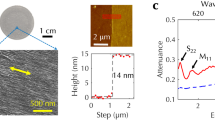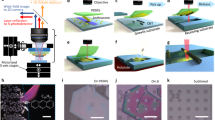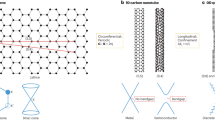Abstract
The one-dimensional character of electrons, phonons and excitons in individual single-walled carbon nanotubes leads to extremely anisotropic electronic, thermal and optical properties. However, despite significant efforts to develop ways to produce large-scale architectures of aligned nanotubes, macroscopic manifestations of such properties remain limited. Here, we show that large (>cm2) monodomain films of aligned single-walled carbon nanotubes can be prepared using slow vacuum filtration. The produced films are globally aligned within ±1.5° (a nematic order parameter of ∼1) and are highly packed, containing 1 × 106 nanotubes in a cross-sectional area of 1 μm2. The method works for nanotubes synthesized by various methods, and film thickness is controllable from a few nanometres to ∼100 nm. We use the approach to create ideal polarizers in the terahertz frequency range and, by combining the method with recently developed sorting techniques, highly aligned and chirality-enriched nanotube thin-film devices. Semiconductor-enriched devices exhibit polarized light emission and polarization-dependent photocurrent, as well as anisotropic conductivities and transistor action with high on/off ratios.
This is a preview of subscription content, access via your institution
Access options
Subscribe to this journal
Receive 12 print issues and online access
$259.00 per year
only $21.58 per issue
Buy this article
- Purchase on Springer Link
- Instant access to full article PDF
Prices may be subject to local taxes which are calculated during checkout




Similar content being viewed by others
References
Jorio, A., Dresselhaus, G. & Dresselhaus, M. S. (eds) Carbon Nanotubes: Advanced Topics in the Synthesis, Structure, Properties and Applications (Springer, 2008).
Ma, Y., Wang, B., Wu, Y., Huang, Y. & Chen, Y. The production of horizontally aligned single-walled carbon nanotubes. Carbon 49, 4098–4110 (2011).
Liu, B., Wang, C., Liu, J., Che, Y. & Zhou, C. Aligned carbon nanotubes: from controlled synthesis to electronic applications. Nanoscale 5, 9483–9502 (2013).
De Heer, W. A. et al. Aligned carbon nanotube films: production and optical and electronic properties. Science 268, 845–847 (1995).
Murakami, Y. et al. Growth of vertically aligned single-walled carbon nanotube films on quartz substrates and their optical anisotropy. Chem. Phys. Lett. 385, 298–303 (2004).
Pint, C. L., Xu, Y., Pasquali, M. & Hauge, R. H. Formation of highly dense, aligned ribbons and ultra-thin films of single-walled carbon nanotubes from carpets. ACS Nano 2, 1871–1878 (2008).
Lynch, M. D. & Patrick, D. L. Organizing carbon nanotubes with liquid crystals. Nano Lett. 2, 1197–1201 (2002).
Lagerwall, J. P. F. & Scalia, G. Carbon nanotubes in liquid crystals. J. Mater. Chem. 18, 2890–2898 (2008).
Zamora-Ledezma, C. et al. Anisotropic thin films of single-wall carbon nanotubes from aligned lyotropic nematic suspensions. Nano Lett. 8, 4103–4107 (2008).
Kim, Y., Minami, N. & Kazaoui, S. Highly polarized absorption and photoluminescence of stretch-aligned single-wall carbon nanotubes dispersed in gelatin films. Appl. Phys. Lett. 86, 073103 (2005).
Shaver, J. et al. Magnetic brightening of carbon nanotube photoluminescence through symmetry breaking. Nano Lett. 7, 1851–1855 (2007).
Mclean, R. S., Huang, X., Khripin, C., Jagota, A. & Zheng, M. Controlled two-dimensional pattern of spontaneously aligned carbon nanotubes. Nano Lett. 6, 55–60 (2006).
Dan, B., Ma, A. W. K., Hároz, E. H., Kono, J. & Pasquali, M. Nematic-like alignment in SWNT thin films from aqueous colloidal suspensions. Ind. Eng. Chem. Res. 51, 10232–10237 (2012).
Oh, J. Y. et al. Easy preparation of self-assembled high-density buckypaper with enhanced mechanical properties. Nano Lett. 15, 190–197 (2015).
Puech, N. et al. Highly ordered carbon nanotube nematic liquid crystals. J. Phys. Chem. C 115, 3272–3278 (2011).
Zakri, C. et al. Liquid crystals of carbon nanotubes and graphene. Phil. Trans. R. Soc. A 371, 20120499 (2013).
Walters, D. A. et al. In-plane-aligned membranes of carbon nanotubes. Chem. Phys. Lett. 338, 14–20 (2001).
Zaric, S. et al. Estimation of magnetic susceptibility anisotropy of carbon nanotubes using magneto-photoluminescence. Nano Lett. 4, 2219–2221 (2004).
Beyer, S. T. & Walus, K. Controlled orientation and alignment in films of single-walled carbon nanotubes using inkjet printing. Langmuir 28, 8753–8759 (2012).
Cao, Q. et al. Arrays of single-walled carbon nanotubes with full surface coverage for high-performance electronics. Nature Nanotech. 8, 180–186 (2013).
Wu, Z. et al. Transparent, conductive nanotube films. Science 305, 1273–1276 (2004).
Zhang, Q. et al. Plasmonic nature of the terahertz conductivity peak in single-wall carbon nanotubes. Nano Lett. 13, 5991–5996 (2013).
Ajiki, H. & Ando, T. Aharonov–Bohm effect in carbon nanotubes. Physica B 201, 349–352 (1994).
Miyauchi, Y., Oba, M. & Maruyama, S. Cross-polarized optical absorption of single-walled nanotubes by polarized photoluminescence excitation spectroscopy. Phys. Rev. B 74, 205440 (2006).
Lefebvre, J. & Finnie, P. Polarized photoluminescence excitation spectroscopy of single-walled carbon nanotubes. Phys. Rev. Lett. 98, 167406 (2007).
Ren, L. et al. Carbon nanotube terahertz polarizer. Nano Lett. 9, 2610–2613 (2009).
Onsager, L. The effects of shape on the interaction of colloidal particles. Ann. NY Acad. Sci. 51, 627–659 (1949).
Yang, P. Nanotechnology: wires on water. Nature 425, 243–244 (2003).
Sharma, R., Lee, C. Y., Choi, J. H., Chen, K. & Strano, M. S. Nanometer positioning, parallel alignment, and placement of single anisotropic nanoparticles using hydrodynamic forces in cylindrical droplets. Nano Lett. 7, 2693–2700 (2007).
Khripin, C. Y., Fagan, J. A. & Zheng, M. Spontaneous partition of carbon nanotubes in polymer-modified aqueous phases. J. Am. Chem. Soc. 135, 6822–6825 (2013).
Subbaiyan, N. K. et al. Role of surfactants and salt in aqueous two-phase separation of carbon nanotubes toward simple chirality isolation. ACS Nano 8, 1619–1628 (2014).
Fagan, J. A. et al. Isolation of specific small-diameter single-wall carbon nanotube species via aqueous two-phase extraction. Adv. Mater. 26, 2800–2804 (2014).
Nanot, S. et al. Broadband, polarization-sensitive photodetector based on optically-thick films of macroscopically long, dense, and aligned carbon nanotubes. Sci. Rep. 3, 1335 (2013).
He, X. et al. Photothermoelectric p–n junction photodetectors with intrinsic polarimetry based on macroscopic carbon nanotube films. ACS Nano 7, 7271–7277 (2013).
Jakubinek, M. B. et al. Thermal and electrical conductivity of tall, vertically aligned carbon nanotube arrays. Carbon 48, 3947–3952 (2010).
Bekyarova, E. et al. Electronic properties of single-walled carbon nanotube networks. J. Am. Chem. Soc. 127, 5990–5995 (2005).
Zhang, D. et al. Transparent, conductive, and flexible carbon nanotube films and their application in organic light-emitting diodes. Nano Lett. 6, 1880–1886 (2006).
Chen, Z., Appenzeller, J., Knoch, J., Lin, Y. & Avouris, P. The role of metal–nanotube contact in the performance of carbon nanotube field-effect transistors. Nano Lett. 5, 1497–1502 (2005).
Acknowledgements
This work was supported by the Basic Energy Sciences (BES) programme of the US Department of Energy through grant no. DE-FG02-06ER46308 (for the preparation and characterization of aligned carbon nanotube films) and the Robert A. Welch Foundation through grant no. C-1509 (for terahertz and infrared characterization). S.K.D. and E.H.H. acknowledge support from the LANL LDRD programme. Portions of this work were performed at the Center for Integrated Nanotechnologies, a US Department of Energy, Office of Science user facility. The authors thank H. Kasai, A. Zubair, C. Sewell, S. Peters and T. Higashira for their assistance with terahertz characterization measurements and I. Kurganskaya, A. Lüttge, R. Headrick and M. Pasquali for discussions.
Author information
Authors and Affiliations
Contributions
X.H. and W.G. developed the process of making aligned CNT films, performed most of the characterization experiments, and analysed the data obtained, under the supervision and guidance of W.W.A., R.H.H. and J.K. L.X. prepared chirality-enriched SWCNT suspensions, in collaboration with E.H.H. and S.K.D. B.L. made the AFM measurements and B.L. and W.W. performed TEM imaging, under the advisement of R.V. and P.M.A. Q.Z. and J.M.R. participated in the terahertz and infrared spectroscopy measurements. S.L. helped characterize the FET devices. X.H., W.G. and J.K. wrote the manuscript. All authors discussed the results and commented on the manuscript.
Corresponding author
Ethics declarations
Competing interests
The authors declare no competing financial interests.
Supplementary information
Supplementary information
Supplementary information (PDF 10089 kb)
Rights and permissions
About this article
Cite this article
He, X., Gao, W., Xie, L. et al. Wafer-scale monodomain films of spontaneously aligned single-walled carbon nanotubes. Nature Nanotech 11, 633–638 (2016). https://doi.org/10.1038/nnano.2016.44
Received:
Accepted:
Published:
Issue Date:
DOI: https://doi.org/10.1038/nnano.2016.44
This article is cited by
-
Biotemplated precise assembly approach toward ultra-scaled high-performance electronics
Nature Protocols (2023)
-
Ultrafast terahertz emission from emerging symmetry-broken materials
Light: Science & Applications (2023)
-
Engineering chirality at wafer scale with ordered carbon nanotube architectures
Nature Communications (2023)
-
Preparation of carbon nanotube films towards mechanical and electrochemical energy storage
Nano Research (2023)
-
Length-dependent alignment of large-area semiconducting carbon nanotubes self-assembly on a liquid-liquid interface
Nano Research (2023)



